INTRODUCTION
Pyorrhea is a condition, wherein the ligaments and bones supporting the teeth get infected and become inflamed. An advanced stage of periodontal disease, it causes bleeding and discharge of pus from the gums. If left untreated pyorrhea can cause halitosis (bad breath) in which the jaw bone is slowly eroded due to painful and bleeding gums.
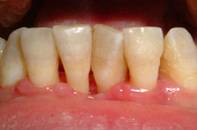
YOGA AND PYORRHEA

YOGA POSES FOR PYORRHEA
Fish Pose
The fish pose is the natural successor of the shoulder stand and it is recommended that you practice it as a counter pose to the stand. The pose implies a compression of the spine and neck as opposed to the stretch obtained while in the shoulder stand or Bridge and Plough poses.
Shoulder Stand Pose
Relax your body and mind, stretch your hamstrings, shoulders, and spine, relieve stress, and improve your posture and concentration by practicing the Seated Forward Bend
Seated Forward Bend Pose
Paschimottanasana (Seated Forward Bend) is a foundation Yoga pose that greatly helps you go within yourself, in a manner that restores both your body and mind. The literal translation of the term Paschimottanasana is "intense stretch of the west." In ancient times yogis were known to bow down to the rising sun in the east. Thus by doing this, intense west stretch they aligned themselves on an east-west axis. How deep physically you go into the pose is not half as important as how much you are able to surrender while doing it.
Wheel Pose
It strengthens the arms, shoulders and upper back as well and stimulates the cardiovascular system. The chakrasana has an overall tonic effect for the entire body. The 'Wheel Pose' has derived its name, because of the peculiar shape the body takes, while performing the asana or pose.
Cobra Pose
Cobra Pose is a heart-opening back bend. The pose challenges the shoulders, the chest, and lengthens the spine. The basic movement of the cobra is to arch the spine backward.
YOGA ASANAS FOR PYORRHEA
SARVANGASNA
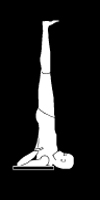
The increased blood flow to the head and upper body helps to heal many disorders such as headaches, nasal congestion and sore throats. This asana is also known as the shoulder stand. The meaning of this asana in Sanskrit is "a posture for the complete body".
Steps
• Exhale and while inhaling, contract the abdomen and slowly raise both the legs to a 90 degree angle from the floor.
• Exhaling raise the waist and the hips from the floor and take the legs backwards over the head.
• Inhaling raise the back and the legs up into a vertical position, placing the hands on the upper back for support. The chin should rest against the chest, creating the chin lock. Fix the eyesight on the toes and maintaining the asana, continue normal breathing.
• One should concentrate on getting the legs; waist and the back in one straight line and making this line 90 degrees with the ground. In this asana the arms up to the elbows are placed on the floor, shoulder width apart.
MATSYASANA
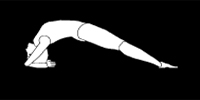
Matsya in Sanskrit means fish. One immediately identifies this asana with the figurative relevance like any other hatha asanas. But here the asana is suggestive of the quality of floating like a fish - a state that's induced by assuming this posture.MatsyasanaTraditional texts state that Matsyasana is the "destroyer of all diseases." This asana is therapeutically helpful in constipation, respiratory faculties, fatigue and anxiety.It's also good for preventing mildly recurring backaches before they go worse.
Steps
• Assume padmasana If it is difficult, assume a comparable posture (Swasthikasana or Sukhasana).
• Bend backwards and touch the ground with the back of your head while not changing the position of your legs.
• Use hands to give support to body so that your body doesn't fall flat. While you lay backwards while keeping the legs as in padmasana, your body assumes the same of a fish, with the legs forming the tailfins. The back, shoulders, neck, most part of head and parts below knee will not touch the ground.
• Now extend your hands and grasp your big toes. Right hand grasps left big toe, which is on the left side of the body.
• Breathe slowly while in Matsyasana pose.
• Take hands backwards and place them on the ground as a support. Slowly raise your head and come to Padmasana pose.
ARDHAMATSYENDRASANA
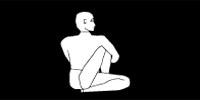
This is highly useful to control diabetes and kidney troubles. This posture makes the spine elastic. Nerves of the spinal column are toned up. This improves the efficiency of the abdominal viscera, such as liver, spleen, pancreas and the intestines. This eliminates the problems of constipation and dyspepsia (loss of appetite). Artha Matsyendrasana is a wonderful asana and gives you a very high standard of health when practiced in combination with the other asanas of forward and backward bending.
Steps
• In this posture twist the waist laterally.
• Exhale and twist the waist in this posture.
• Inhale after you return to normal sitting position.
• Symmetry should always be maintained.
• If you twist your body six times to the left, you should also twist your body six times to the right.
PASCHIMOTTANASANA
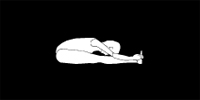
Paschimottanasana is a fine stretching exercise of the body. In one continuous movement, almost all the posterior muscles get fully stretched and relaxed. This helps to improve the functions of the abdominal organs and sets right respiratory disorders. It also helps to improve memory.
Steps
• This posture involves stretching of the posterior muscles of the body.
• While sitting, stretch your legs forward and keep them close to each other. Bend a little forward, make hooks of your fingers and hold the big toes on the respective sides.
• While exhaling, bend forward stretching the trunk along the thighs. Rest your on the knees, which should be kept straight.
• Gradually, the tense muscles can be made supple for securing the complete posture. Inhale and return to the original position
SIDDHASANA
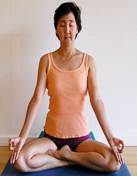
The Sanskrit word "Siddha" refers to "accomplished" or "adept". Though Siddhasana requires lesser flexibility of legs in comparison to Padmasana, it still, facilitates concentration, relaxation and meditation bringing about a balance of mind and body.
Steps
• Sitting on the floor, stretch the legs straight in front. The spine should be kept erect and continue normal breathing.
• Fold the left leg at the knee and bring it to the front. Gently stretch the toes and ankle so that they appear to be in straight line. In case, one finds it difficult, try to stretch the toes as much as is easily possible. The left knee should touch the floor.
• Next fold the right leg at the knee and placing the right foot in such as way that it rests on the left foot.
• Gently stretch the ankle and toes of the right leg so that it appears to be in a straight line.
• The Spine should be kept straight and the palms should be placed on the knees facing upwards. Alternatively, the palms can be placed on respective knees forming a circle with forefinger and the thumb and rest of the fingers kept straight. Continue normal breathing.
• Try to stay in this position for a minute. While returning to normal position, loosen the fingers of hands first, then unlock the right leg by using hands and place it on the floor and repeat the same for left leg and stretch out the legs.
• Rest for a few seconds before repeating this process again by switching the legs with right foot underneath the left foot.
ASTROLOGY
Astrology has never been as popular as it is today. This is because more and more people are realizing the possibilities that Astrology can offer. Astrology can provide you with a deeper insight into your career path, your relationships, your home life, your relationship with money and the world at large. Its scope is broad because it is a symbolic reflection of life itself. According to astrological reports for yoga asanas the above mentioned asanas are said to be effective for those who come under the following zodiac sign.
• ARIES